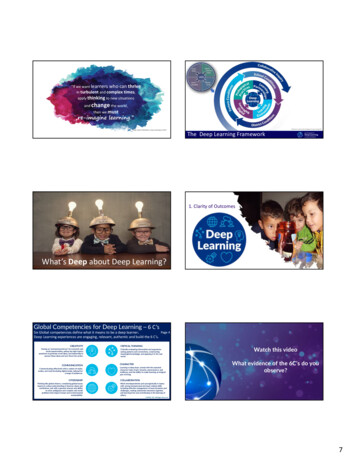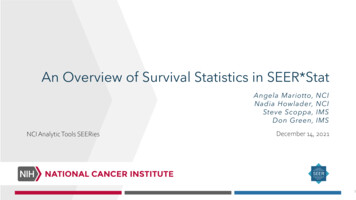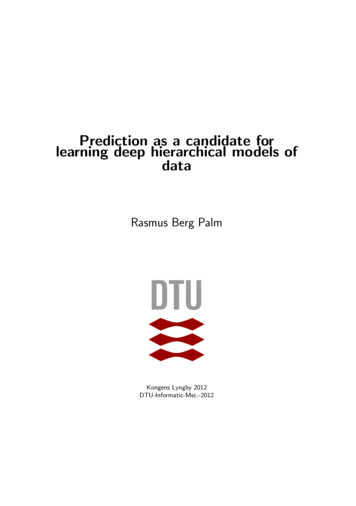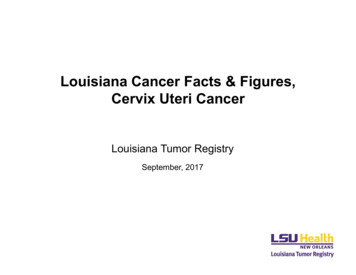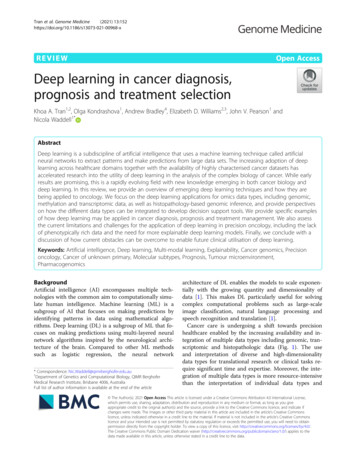
Transcription
Tran et al. Genome Medicine(2021) VIEWOpen AccessDeep learning in cancer diagnosis,prognosis and treatment selectionKhoa A. Tran1,2, Olga Kondrashova1, Andrew Bradley4, Elizabeth D. Williams2,3, John V. Pearson1 andNicola Waddell1*AbstractDeep learning is a subdiscipline of artificial intelligence that uses a machine learning technique called artificialneural networks to extract patterns and make predictions from large data sets. The increasing adoption of deeplearning across healthcare domains together with the availability of highly characterised cancer datasets hasaccelerated research into the utility of deep learning in the analysis of the complex biology of cancer. While earlyresults are promising, this is a rapidly evolving field with new knowledge emerging in both cancer biology anddeep learning. In this review, we provide an overview of emerging deep learning techniques and how they arebeing applied to oncology. We focus on the deep learning applications for omics data types, including genomic,methylation and transcriptomic data, as well as histopathology-based genomic inference, and provide perspectiveson how the different data types can be integrated to develop decision support tools. We provide specific examplesof how deep learning may be applied in cancer diagnosis, prognosis and treatment management. We also assessthe current limitations and challenges for the application of deep learning in precision oncology, including the lackof phenotypically rich data and the need for more explainable deep learning models. Finally, we conclude with adiscussion of how current obstacles can be overcome to enable future clinical utilisation of deep learning.Keywords: Artificial intelligence, Deep learning, Multi-modal learning, Explainability, Cancer genomics, Precisiononcology, Cancer of unknown primary, Molecular subtypes, Prognosis, Tumour ial intelligence (AI) encompasses multiple technologies with the common aim to computationally simulate human intelligence. Machine learning (ML) is asubgroup of AI that focuses on making predictions byidentifying patterns in data using mathematical algorithms. Deep learning (DL) is a subgroup of ML that focuses on making predictions using multi-layered neuralnetwork algorithms inspired by the neurological architecture of the brain. Compared to other ML methodssuch as logistic regression, the neural network* Correspondence: Nic.Waddell@qimrberghofer.edu.au1Department of Genetics and Computational Biology, QIMR BerghoferMedical Research Institute, Brisbane 4006, AustraliaFull list of author information is available at the end of the articlearchitecture of DL enables the models to scale exponentially with the growing quantity and dimensionality ofdata [1]. This makes DL particularly useful for solvingcomplex computational problems such as large-scaleimage classification, natural language processing andspeech recognition and translation [1].Cancer care is undergoing a shift towards precisionhealthcare enabled by the increasing availability and integration of multiple data types including genomic, transcriptomic and histopathologic data (Fig. 1). The useand interpretation of diverse and high-dimensionalitydata types for translational research or clinical tasks require significant time and expertise. Moreover, the integration of multiple data types is more resource-intensivethan the interpretation of individual data types and The Author(s). 2021 Open Access This article is licensed under a Creative Commons Attribution 4.0 International License,which permits use, sharing, adaptation, distribution and reproduction in any medium or format, as long as you giveappropriate credit to the original author(s) and the source, provide a link to the Creative Commons licence, and indicate ifchanges were made. The images or other third party material in this article are included in the article's Creative Commonslicence, unless indicated otherwise in a credit line to the material. If material is not included in the article's Creative Commonslicence and your intended use is not permitted by statutory regulation or exceeds the permitted use, you will need to obtainpermission directly from the copyright holder. To view a copy of this licence, visit http://creativecommons.org/licenses/by/4.0/.The Creative Commons Public Domain Dedication waiver ) applies to thedata made available in this article, unless otherwise stated in a credit line to the data.
Tran et al. Genome Medicine(2021) 13:152Page 2 of 17Fig. 1 Deep learning may impact clinical oncology during diagnosis, prognosis and treatment. Specific areas of clinical oncology where deeplearning is showing promise include cancer of unknown primary, molecular subtyping of cancers, prognosis and survivability and precisiononcology. Examples of deep learning applications within each of these areas are listed. The data modalities utilised by deep learning models arenumerous and include genomic, transcriptomic and histopathology data categories covered in this reviewneeds modelling algorithms that can learn from tremendous numbers of intricate features. The use of ML algorithms to automate these tasks and aid cancer detection(identifying the presence of cancer) and diagnosis (characterising the cancer) has become increasingly prevalent [2,3]. Excitingly, DL models have the potential to harnessthis complexity to provide meaningful insights and identify relevant granular features from multiple data types [4,5]. In this review, we describe the latest applications ofdeep learning in cancer diagnosis, prognosis and treatment selection. We focus on DL applications for omicsand histopathological data, as well as the integration ofmultiple data types. We provide a brief introduction toemerging DL methods relevant to applications covered inthis review. Next, we discuss specific applications of DL inoncology, including cancer origin detection, molecularsubtypes identification, prognosis and survivability prediction, histological inference of genomic traits, tumourmicroenvironment profiling and future applications inspatial transcriptomics, metagenomics and pharmacogenomics. We conclude with an examination of current challenges and potential strategies that would enable DL to beroutinely applied in clinical settings.Emerging deep learning methodsCovering all DL methods in detail is outside the scope ofthis review; rather, we provide a high-level summary ofemerging DL methods in oncology. DL utilises artificialneural networks to extract non-linear, entangled andrepresentative features from massive and highdimensional data [1]. A deep neural network is typicallyconstructed of millions of densely interconnected computing neurons organised into consecutive layers. Withineach layer, a neuron is connected to other neurons inthe layer before it, from which it receives data, and otherneurons in the layer after it, to which it sends data.When presented with data, a neural network feeds eachtraining sample, with known ground truth, to its inputlayer before passing the information down to all succeeding layers (usually called hidden layers). This information is then multiplied, divided, added and subtractedmillions of times before it reaches the output layer,which becomes the prediction. For supervised deeplearning, each pair of training sample and label is fedthrough a neural network while its weights and thresholds are being adjusted to get the prediction closer tothe provided label. When faced with unseen (test) data,
Tran et al. Genome Medicine(2021) 13:152these trained weights and thresholds are frozen and usedto make predictions.Fundamental neural network methodsThere are multiple neural network-based methods, allwith different advantages and applications. Multilayerperceptron (MLP), recurrent neural network (RNN) andconvolutional neural network (CNN) are the most fundamental and are frequently used as building blocks formore advanced techniques. MLPs are the simplest typeof neural networks, where neurons are organised in consecutive layers so that signals travel through the networkin one direction (from input to output) [1]. AlthoughMLPs can perform well for generic predictions, they arealso prone to overfitting [6]. RNNs process an input sequence one element at a time, while maintaining historyof all past elements in hidden ‘state vector(s)’. Outputpredictions are made at every element using informationfrom the current element and also previous elements [1,7]. RNNs are typically used for analysing sequential datasuch as text, speech or DNA sequences. By contrast,CNNs are designed to draw spatial relationships fromimage data. CNNs traverse an image and apply smallfeature-filter matrices, i.e. convolution filters, to extractgranular features [1]. Features extracted by the last convolution layer are then used for making predictions.CNNs have also been adapted for analysis of non-imagedata, e.g. genomic data represented in a vector, matrixor tensor format [8]. A review by Dias and Torkamani[7] described in detail how MLPs, RNNs and CNNs operate on biomedical and genomics data. Moreover, theuse of MLPs, RNNs and CNNs to assist clinicians andresearchers has been proposed across multiple oncologyareas, including radiotherapy [9], digital histopathology[10, 11] and clinical and genomic diagnostics [7]. Whileroutine clinical use is still limited, some of the modelshave already been FDA-approved and adopted into aclinical setting, for example CNNs for the prediction ofmalignancy in pulmonary nodules detected by CT [12],and prostate and breast cancer diagnosis predictionusing digital histopathology [13, 14].Advanced neural-network methodsGraph convolutional neural networks (GCNNs) generalise CNNs beyond regular structures (Euclidean domains)to non-Euclidean domains such as graphs which have arbitrary structure. GCNNs are specifically designed toanalyse graph data, e.g. using prior biological knowledgeof an interconnected network of proteins with nodesrepresenting proteins and pairwise connections representing protein–protein interactions (PPI) [15], using resources such as the STRING PPI database [16] (Fig. 2a).This enables GCNNs to incorporate known biologicalassociations between genetic features and perceive theirPage 3 of 17cooperative patterns, which have been shown to be useful in cancer diagnostics [17].Semantic segmentation is an important CNN-basedvisual learning method specifically for image data (Fig.2b). The purpose of semantic segmentation is to produce a class label for every single pixel in an image andcluster parts of an image together into each class, wherethe class represents an object or component of theimage. Semantic segmentation models are generally supervised, i.e. they are given class labels for each pixeland are trained to detect the major ‘semantics’ for eachclass.To enhance the predictive power of DL models, different data types (modalities) can be combined using multimodal learning (Fig. 2c). In clinical oncology, datamodalities can include image, numeric and descriptivedata. Cancer is a complex and multi-faceted disease withlayers of microscopic, macroscopic and molecular features that can separately or together influence treatmentresponses and patient prognosis. Therefore, combiningclinical data (e.g. diagnostic test results and pathologyreports), medical images (e.g. histopathology and computed tomography) and different types of omics data,such as genomic, transcriptomic and proteomic profiles,may be useful. The two most important requirementsfor a multimodal network are the ability to create representations that contain dense meaningful features of theoriginal input, and a mathematical method to combinerepresentations from all modalities. There are severalmethods capable of performing the representative learning task, e.g. CNNs, RNNs, deep belief networks andautoencoders (AE) [21]; score-level fusion [22]; or multimodal data fusion [23]. The multimod
accelerated research into the utility of deep learning in the analysis of the complex biology of cancer. While early results are promising, this is a rapidly evolving field with new knowledge emerging in both cancer biology and deep learning. In this review, we provide an overview of emerging deep learning techniques and how they are
